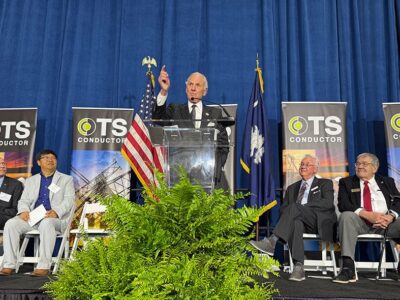“Mean Green” is the name of the University of North Texas football team; however, the University also “means green” when it comes to its dedication to environmental issues. In 2008, the University became the first large Texas university to sign the American College and University Presidents’ Climate Commitment (ACUPCC) and pledging to reach carbon neutrality by 2040. That year, UNT also launched plans to build a sustainably designed stadium. When Apogee Stadium opened in 2011, it received a Platinum LEED rating – the highest possible LEED rating – and the first collegiate stadium ever to achieve Platinum certification.
Apogee achieved this prestigious award, the country’s top honor for sustainable buildings, before the stadium’s signature symbol – three towering wind turbines (standing 121-feet tall with 30-foot blades) – became operational in 2012. Generating nearly 500,000 kWh annually, the turbine trio provides a third of Apogee’s energy consumption, which equates to 323 metric tons of CO2 emissions never entering the earth’s atmosphere.
When Apogee Stadium isn’t in use, the turbines provide electricity to the University’s stadium-adjacent Eagle Point campus, supplying around 6 percent of its energy.
These wind turbines are notable too because they positioned Apogee as the first new college stadium to utilize on-site renewable energy. “Having the first LEED Platinum collegiate athletic stadium in the world and the first stadium powered with wind turbines greatly strengthens the sustainability identity and visibility of UNT,” as Lauren Helixon, assistant director of UNT’s Sustainability Department, told the Natural Resources Defense Council.
The turbines, however, are just the tip of the iceberg when it comes to Apogee Stadium’s electricity-saving initiatives. A real-time Building Automatic System (BAS) increases energy efficiency due to its ability to adjust the air conditioning, heating, shades, and ventilation. Similarly, the operation of Mechanical/Electrical/Plumbing (MEP) equipment can be minimized on days when the stadium isn’t in use, while improved lighting controls result in a reduction in lighting power density levels, thereby diminishing carbon emissions. Overall, the stadium can realize a 25 percent reduction in energy costs compared to standard building energy baselines.
The installation of low-flow plumbing fixtures, meanwhile, has led to water consumption that was more than 50 percent lower than typical usage in same-sized buildings.
Decreased electricity use (and, consequently, fewer carbon emissions creation) also is achieved because Apogee Stadium’s thoughtful design allows for natural daylight or views of the outdoors across 90 percent of the typically occupied interior space. Sustainability, moreover, was given careful consideration by the University, and its partners Manhattan Construction and the HKS Sports and Entertainment architectural group, throughout the stadium’s planning and construction. Nearly half of the building products and materials were manufactured locally, while 20 percent were made with recycled materials. Approximately 80 percent of the construction waste materials (from 6,373 tons of concrete to 188 tons of metal) avoided being dumped in landfills by being recycled. Low-VOC adhesives, sealants, paints, coatings, flooring, fly ash, and other materials containing low levels of volatile organic compounds were used to improve the indoor air quality inside the stadium.

Eco-considerations were taken too with the stadium’s grounds. HKS architects conceived the stadium so it would fit into the location’s sloping terrain. Not only was a grove of Post Oak trees preserved, but over half of the stadium’s landscaping features plantings native to North Texas’ drought-susceptible climate. The use of native plants, combined with installing permeable ground and retention ponds, serve to lessen heat island effects and stormwater runoff as well as lowering potable water irrigation needs by 75 percent.
Apogee Stadium’s triumphant sustainability achievements have had a profound impact at the University of North Texas. “The green features of the stadium provide a model for both existing and future projects,” Helixon stated in a Natural Resources Defense Council report, adding, “the installation of wind turbines on the UNT campus influences potential research in sustainability and renewable energy technology.”
Examples of the University’s environmental projects are evident around its campus. Boasting six LEED-certified buildings, UNT has improved energy efficiency in 120 existing buildings, resulting in an annual savings of $3 million. In 2017, the university switched to utilizing 100 percent renewable energy, which was achieved through renewable energy credit (an idea suggested by a philosophy professor). eCollegeFinder has ranked UNT as Texas’ greenest college, while the Princeton Review has included UNT in its “Guide To Green Colleges” for many years.

When Apogee Stadium received its LEED certification, V. Lane Rawlins, UNT’s president emeritus, proclaimed: “UNT is a leader in environmental research and sustainability, and the fact that we have the first LEED Platinum football stadium is an example of our commitment and our plans for the future.”





